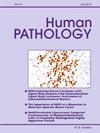Clinicopathological characteristics and immune infiltration analysis of esophagogastric junction adenocarcinoma with alterations in SWI/SNF complex
IF 2.6
2区 医学
Q2 PATHOLOGY
引用次数: 0
Abstract
Background
Alterations in SWI/SNF complex were mostly detected in poorly differentiated or undifferentiated gastric/esophagogastric junction adenocarcinoma (EGJA). However, there was a lack of studies investigating these alterations in a consecutive series of cases regardless of the morphology. Therefore, our study aimed to clarify the clinicopathological, prognostic, molecular and immune infiltration characteristics of a consecutive series cases with altered SWI/SNF complex in EGJA.
Methods
We retrospectively analysed 266 patients who underwent surgery without neoadjuvant therapy. Tissue microarrays were constructed for evaluating molecular markers (INI1, ARID1A, BRM, BRG1, MLH1, PMS2, MSH2, MSH6, EGFR, c-MET, HER2, p53 and PD-L1) and immune cell markers (CD3, CD4, CD8, CD68 and CD163). Immune cell counts were quantified using Qupath.
Results
Among the 266 patients, 36 (13.5 %) cases exhibited alterations in SWI/SNF complex. Specifically, 14 (5.3 %) cases were identified with ARID1A alteration, 21 (7.9 %) cases with BRG1 alteration, 7 (2.7 %) cases with altered BRM and 2 (0.8 %) cases with INI1 alteration. Alterations in ARID1A correlated with deficient mismatch repair (dMMR) (p < 0.001), increased CD3+T-cell (p = 0.017) and relatively increased CD8+ T-cell infiltration (p = 0.057), whereas alterations of BRG1 correlated with reduced CD3+T-cell infiltration(p = 0.036). There were no significant differences in clinicopathological or prognostic characteristics in EGJA patients with or without SWI/SNF or its subunits alterations.
Conclusion
Our findings indicate that the SWI/SNF complex demonstrates a notable frequency of alteration within the consecutive series of cases of EGJA. Alterations in ARID1A and BRG1 may correlate with distinct tumor microenvironment, which may provide new insights for optimizing treatment strategies in patients with SWI/SNF complex alterations.
食管胃交界腺癌伴SWI/SNF复合物改变的临床病理特征及免疫浸润分析。
背景:SWI/SNF复合物的改变主要在低分化或未分化胃/食管胃交界腺癌(EGJA)中检测到。然而,缺乏在连续的一系列病例中调查这些改变的研究,而不考虑形态学。因此,我们的研究旨在阐明连续系列EGJA中SWI/SNF复合物改变病例的临床病理、预后、分子和免疫浸润特征。方法:我们回顾性分析266例未接受新辅助治疗的手术患者。构建组织微阵列,评估分子标记(INI1、ARID1A、BRM、BRG1、MLH1、PMS2、MSH2、MSH6、EGFR、c-MET、HER2、p53和PD-L1)和免疫细胞标记(CD3、CD4、CD8、CD68和CD163)。使用Qupath定量免疫细胞计数。结果:266例患者中,36例(13.5%)出现SWI/SNF复合物改变。其中,ARID1A改变14例(5.3%),BRG1改变21例(7.9%),BRM改变7例(2.7%),INI1改变2例(0.8%)。ARID1A的改变与错配修复缺陷(dMMR) (p+ t细胞(p=0.017)和CD8+ t细胞浸润相对增加(p=0.057)相关,而BRG1的改变与CD3+ t细胞浸润减少相关(p=0.036)。伴有或不伴有SWI/SNF或其亚基改变的EGJA患者的临床病理或预后特征无显著差异。结论:我们的研究结果表明,在连续的EGJA系列病例中,SWI/SNF复合物显示出显著的改变频率。ARID1A和BRG1的改变可能与不同的肿瘤微环境相关,这可能为优化SWI/SNF复杂改变患者的治疗策略提供新的见解。
本文章由计算机程序翻译,如有差异,请以英文原文为准。
求助全文
约1分钟内获得全文
求助全文
来源期刊

Human pathology
医学-病理学
CiteScore
5.30
自引率
6.10%
发文量
206
审稿时长
21 days
期刊介绍:
Human Pathology is designed to bring information of clinicopathologic significance to human disease to the laboratory and clinical physician. It presents information drawn from morphologic and clinical laboratory studies with direct relevance to the understanding of human diseases. Papers published concern morphologic and clinicopathologic observations, reviews of diseases, analyses of problems in pathology, significant collections of case material and advances in concepts or techniques of value in the analysis and diagnosis of disease. Theoretical and experimental pathology and molecular biology pertinent to human disease are included. This critical journal is well illustrated with exceptional reproductions of photomicrographs and microscopic anatomy.
 求助内容:
求助内容: 应助结果提醒方式:
应助结果提醒方式:


